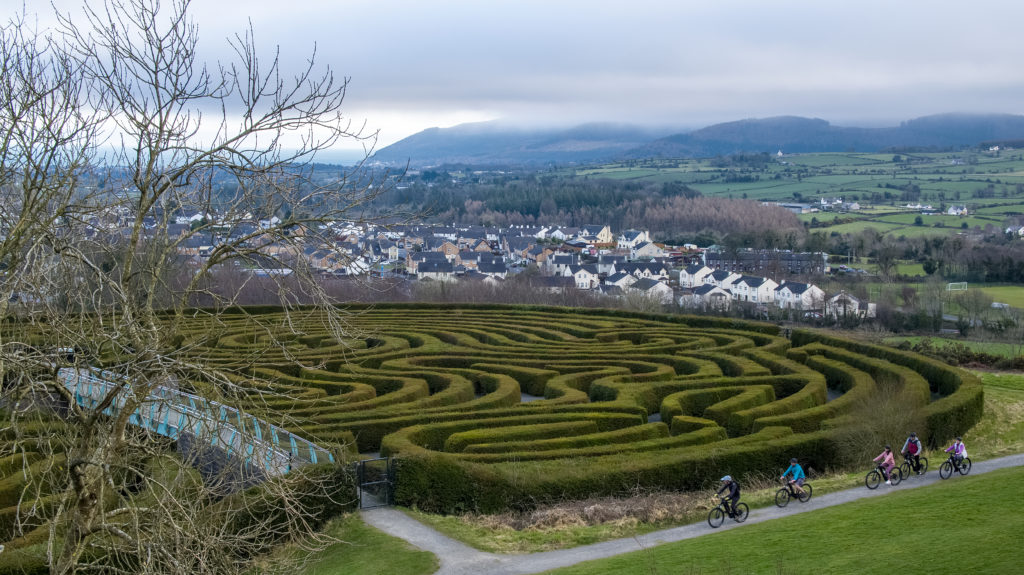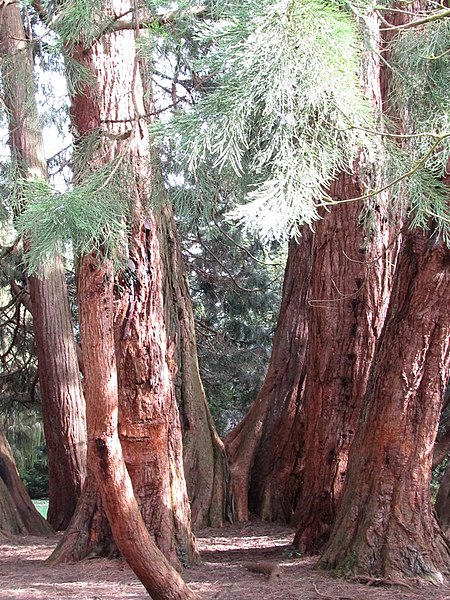“HEY, turn left, love!” the woman shouted. I was in two minds. I’d reached a crossroads in the great County Down maze in Castlewellan. In fact one of the largest hedge labyrinths in the world. The Peace Maze consists of 6,000 yew trees with an overall length in excess of two miles.
I didn’t know the woman but had nodded to her ten minutes earlier on an other stretch of hedge. She was evidently following the “left hand rule” which gets you out of most mazes: always take the first turning to the left. I'd been using it myself but had faltered as I appeared to be heading back to the centre. But my new maze friend was adamant. A left turn would see us right, so to speak. She said she was from nearby, in Moneyscalp — "Just up the road." Puzzlingly, she thought this little bit of local knowledge would help us gain our freedom. And do you know, her instincts were right. Within ten minutes we were out. "Ach I told ye," she said. "I was in a hurry to get home so couldn't afford a wrong turn."
I was puzzled again. This was turning into a day of puzzles. If I were in a hurry to get home, I suspect the last thing I'd say to myself would be, "Hang about. Maybe I should just have a go at one of the most complex mazes in Europe first."
But I'd no chance to find out what my new friend's agenda had been. She was off a rate of knots. In the direction of Moneyscalp, right enough.
 The Peace Maze (image Tourism Ireland)
The Peace Maze (image Tourism Ireland)THE MAZE is a daunting task, and before you ask, no it’s not true that the Northern Ireland Protocol was based on this particular labyrinthine walk. But it's only one of Castlewellan's charms.
The Forest Park has recently secured a prestigious green flag award for the first time. Managed by Keep Northern Ireland Beautiful, the awards have been going since 1996 and are more or less the Nobel Prize in green spaces in the province. So, well done all concerned.
The thing is, Castlewellan richly deserves any honours going. A conifer and broadleaf woodland, it boasts a very big lake (haughty swans included), nature trails, an orienteering route, and an outrageous faux castle built in the Scottish baronial style. You expect to hear the skirl of bagpipes any minute.
The demesne’s most noteworthy asset is its arboretum — or the Castlewellan Arboretum and Annesley Garden as it likes to be called on formal occasions. This walled horticultural haven is stuffed with tree A-listers, ranging from Tibetan rhododendrons to sequoias from California.
The demesne dates back to mediaeval times, once being the des res of local overlords the Maginnis clan. The Annesley family, part of Anglo-Irish ascendancy — or the Raj in the Rain as they’re sometimes called — bought the estate in 1741 and after centuries of planning, planting, pruning, coppicing, shaping, hoeing and weeding one of the finest gardens in Europe emerged.
Some of the champion trees include Japanese maples crowded round the Victorian Heron Fountain, Persian ironwoods along the herbaceous borders, and the Arbutus or strawberry trees that grow not far from enormous sequoias. And although Dawn Redwood sounds like a country singer, she isn't: she's just one of the biggest and most beautiful trees you'll ever see.
I’d tell you where the redwoods stand, but to be honest you can’t really miss them. They're the size of cathedrals.
 WOODY GIANTS The redwoods in Castlewellan Forest (picture by Eric Jones on Wikimedia Commons)
WOODY GIANTS The redwoods in Castlewellan Forest (picture by Eric Jones on Wikimedia Commons)What you might miss, however, are the two unassuming cypress trees just in their lee. These are the parents of all X Cupressocyparis leylandii worldwide, better known as Castlewellan Gold, and a place of pilgrimage from fans worldwide.
This ubiquitous cypress owes its existence to the head gardener John Keown, way back in 1962. It might have been the swinging sixties (although to some extent they passed Castlewellan by) but Mr Keown had grafting not swinging on his mind in any case. One day he picked up a branch of Cupressus macrocarpa ‘Lutea’ which had been broken off by the snow. Extracting the seeds — it was a slow day — he sowed the mutant. The rest, as they say, is horticulture.
Today millions of Castlewellan Gold offspring grace the gardens of the world.
To be fair, dense hedges of cypress trees aren’t everybody’s cup of tea — but in terms of climate change they soak up carbon dioxide. Which is borne out by something I first heard in Castlewellan — QUESTION: When is the best time to plant a tree? ANSWER: About thirty years ago.
QUESTION: So when’s the second best time to plant a tree: ANSWER: Now.
Time to drag ourselves away from this arboreal philosophising.
Now take the path along the north shore of the lake through the Autumn Wood. Soon the route branches and we’re on our way through fir, spruce and pine - on an uphill walk that could best be described as bracing. After some 20 minutes climb the Mountain Lake near the summit of Slievenaslat heaves into view. It's beautiful, and from here you're rewarded with a fine view of the Mourne Mountains doing their party piece of sweeping doen to the sea.
No wonder the estate now has its own green flag award.
What would be a nice touch is if at the award ceremony (I’m assuming there’ll be one) they get a descendant of the Hollywood actress Greer Garson to accept the prize.
Eileen Greer Garson, who was born in London, had family roots in Castlewellan. The latter is often given as her birthplace as she spent much of her childhood in County Down. Presented with the Academy Award for Best Actress in 1942 for her role in Mrs. Miniver, the Guinness World Records credits her with the longest Oscar acceptance speech of all time. After her, the Academy Awards instituted a time limit. But no need for that here. Castlewellan is such a languid place that whoever gets the award can ramble on for hours. No one will mind. Not even the woman from Moneyscalp, no matter how much of a hurry she was in.

